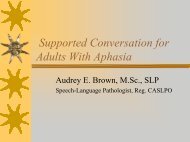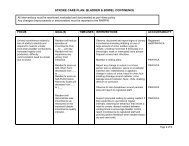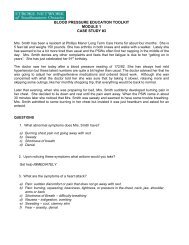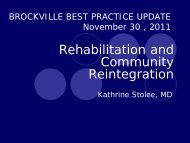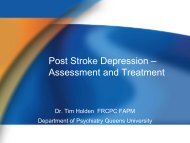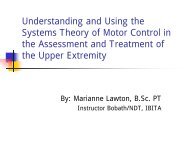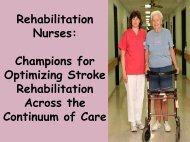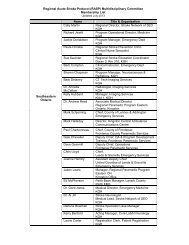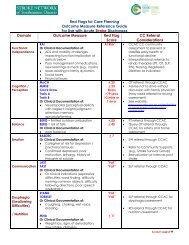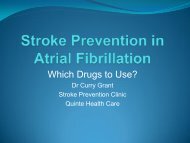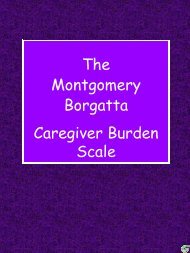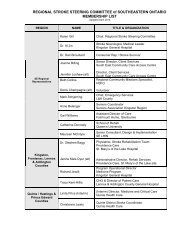Post Stroke Complications - The Stroke Network of Southeastern ...
Post Stroke Complications - The Stroke Network of Southeastern ...
Post Stroke Complications - The Stroke Network of Southeastern ...
- No tags were found...
Create successful ePaper yourself
Turn your PDF publications into a flip-book with our unique Google optimized e-Paper software.
<strong>Post</strong> <strong>Stroke</strong> <strong>Complications</strong>Laura MacIsaac<strong>Stroke</strong> Specialist Case Manager<strong>Stroke</strong> Strategy <strong>of</strong> <strong>Southeastern</strong> Ontario
Learning Objectives• Identify complications <strong>of</strong> stroke acrossthe continuum• Examine key prevention strategies• Identify early identification
Why is it important?• LOS• mortality• morbidity• outcomes
Neurological <strong>Complications</strong>“Nurses in all settings should recognizethat signs <strong>of</strong> neuro status may berelated to neuro OR medicalcomplications.”
Neurological<strong>Complications</strong>Medical<strong>Complications</strong>• Hemorrhagictransformation• Infarct extension• Cerebral edema, ICP• Second stroke• Seizures• Hypoglycemia• Hyponatremia• Infection• MI
Hemorrhagic Transformation• Presents in first couple weeks• Risk dependent on size, location, etiologyInfarct ExtensionCerebral Edema with ICP• Peak time 3-5 days• At risk patients include those with majorintracranial artery occlusion with multilobarinfarcts OR obstructive hydrocephalus
Prevention• Blood pressure, temperature control,euglycemicIdentification – Signs & Symptoms• Change in LOC – confusion, restlessness,combativeness, lethargy• Headache• motor strength• coordination• Speech/language changes
Additional <strong>Stroke</strong>• est risk immediately poststroke• Risk 33% within 2 yearsPrevention• Secondary meds; life stylechangesIdentification• <strong>The</strong> 5 warning signs <strong>of</strong> strokeHEADACHE
Seizures• 85% occur in the 1 st 72 hours• Affects ~ 10% <strong>of</strong> stroke survivorsTreatment• Rule out metabolic causes• Initiate anticonvulsants as required
Skin breakdown“Nurses in all setting should assess forpressure ulcer development, which isdetermined by the combination <strong>of</strong> clinicaljudgment and the use <strong>of</strong> a reliable riskassessment tool.”
When?•At any time during hospitalizationWho?• est risk are those who are incontinent; thosewith: vascular disease, sensory loss, neglect,bilateral motor deficits, elderly, nutrition status•Incidence is 14.5%Resource – BPG: Risk Assessment & Prevention <strong>of</strong> Pressure Ulcers
Prevention• pressure and shearing; positioning;seating; mattress selection, adequate dietand hydration, early mobilization
Falls“Nurses in all practice settings shouldassess stroke clients’ fall risk onadmission and after a fall using avalidated tool.”
When?• Anytime during hospitalizationWho?• risk with cognitive impairments, visual orsensory loss, incontinence, neglect, impairedpostural stability, bilateral motor impairmentPrevention• Fall risk assessment on admission and withchanges in status, low bed, bed alarm, frequenttoileting, frequent bed checks, etc.
STRATIFYScore 1 point for each <strong>of</strong>the following thatapplies:1. Fall is presenting c/o2. Unstable gait3. Agitation present4. Frequent toileting5. Visual disturbanceScore <strong>of</strong> > 2 indicateshigh risk <strong>of</strong> fallTIMED UP AND GOMeasurees physicalmobility in ambulatoryfrail elderlyPatient is timed gettingup from chair, walking3 meters, turning,walking back to chair,and sitting down againMay use aids (cane,walker) but no staffassist.Resource – BPG: Prevention <strong>of</strong> Falls & Injury in the Older Adult
“Nurses in all practice settings shouldassess for the following strokecomplications:•Painful hemiparetic shoulder•Spasticity/contractures•Deep vein thrombosis…”
Shoulder and Joint InjuryWhen?• Most common 2-3 weeksWho?• Most common withhemparetic shoulderPrevention• Positioning, limb supporthttp://www.msjensen.gen.umn.edu/webanatomy/Images/Bones
Spasticity and ContracturesWhen?• Incidence is 19-38% at 3 months – 1 yearPrevention?• Proper positioning•ROM• Splinting• Medications
DVT / PEInformation provided by the Society <strong>of</strong> Interventional Radiology,www.SIRweb.org © 2005
• DVT 20 – 70% PE 10% mortalityPrevention• Heparin prophylaxis ’s DVT risk by 50%• Antiembolic stockings• Early mobilization• Adequate hydrationIdentification• Asymmetrical pain, tenderness, swelling,discolouration• Ultrasound is gold standard
PainCauses• Spasticity• Joint injury, shoulder subluxation• Pre-existing arthritis/neuropathies• NeurogenicPrevention• Positioning, ROM, splints, assistive devicesAssessment
Dysphagia“Nurses should maintain all paclients withstroke NPO (including oral medications)until a swallowing screen is administeredand interpreted, within 24 hours <strong>of</strong> theclient being awake and alert.”
When?• For those at risk, anytime but increases withfatigueWho?• 50% <strong>of</strong> all stroke patients• Mortality rate is 20% within the 1 st year d/taspiration pneumonia• 50% <strong>of</strong> all aspirations are SILENT• ’s risks <strong>of</strong> malnutrition, dehydration,aspiration pneumonia
Prevention <strong>of</strong> <strong>Complications</strong>• NPO until swallowing assessmentcompleted• Oral hygience before & after feeding• Promote self-feeding• Position HOB at 90 degrees for 30 minutespost feeding• Neck positioning (not extended)
Identification <strong>of</strong> DysphagiaScreening is needed to identify those at riskPotential Swallowing Deficit – S&S•Pocketing food•Excessive throatswallowing•Copious PO and/orpulmonary secretions•Drooling•Slow effortful eating•Difficulties swallowing•Coughing whileswallowing•Wet sounding voice•Weak cough voiceGag reflex = Safe swallowing
Nutrition“Nurses in all practice settings shouldcomplete a nutrition and hydration screenwithin 48 hours <strong>of</strong> admission, after apositive dysphagia screen & with changesin neurological or medical status.”
• Incidence as high as 50% in rehab patients 2 weekspost stroke (higher in the 16% malnourished prior totheir stroke)Prevention• Assess intake & ability to feed. Advocate. DietitianconsultIdentification• Physical – thin, weak, cachetic, dry mucousmembranes/hair• Recent weight loss > 10 lbs• Recent intake• Comorbid Conditions – diabetes, CRF, Ca, AIDs• At risk – depressed, cognitive deficits, visual/sensorydeficits
Urinary Tract complications•UTI occurs in ~ 40% <strong>of</strong> patients•Urinary incontinence affects 32-79%Interventions•Early assessment for retention orincontinence•Avoid use <strong>of</strong> indwelling catheters•Regular toileting
OthersDepressionCognitive and perceptual deficitsNeglectAphasiaApraxia
Take home message1. Primary goal is prevention2. Early identification and treatment3. Be aware <strong>of</strong> available resources<strong>The</strong> staff RN can positively impact theoutcomes <strong>of</strong> stroke patients inthroughout the entire continuum <strong>of</strong> care.
References1. Best Practice Guidelines for <strong>Stroke</strong> Care, Heart& <strong>Stroke</strong> Foundation <strong>of</strong> Ontario, 2003.2. Management <strong>of</strong> Acute <strong>Stroke</strong>, Heart & <strong>Stroke</strong>Foundation <strong>of</strong> Ontario, 20043. <strong>Stroke</strong> Assessment Across the Continuum <strong>of</strong>Care, Heart & <strong>Stroke</strong> Foundation <strong>of</strong> Ontario andthe Registered Nurses’ Foundation <strong>of</strong> Ontario,June 2005



